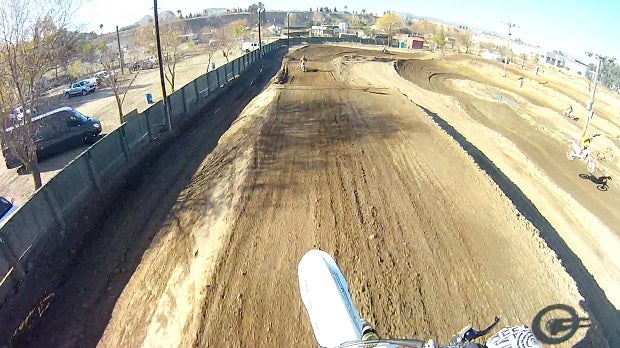
It’s amazing to think of just how far cameras have come in such a short time. It was only about 10 years ago I was still using a custom-made, fiberglass waterhousing for surfing and PWC photography that sealed using a ¼-inch heavy-duty grommet and was tightened into place with wing nuts. Mind you, I was still shooting with film as well. At that time, digital photography was still in the early stages, and the technology was still pretty expensive and not yet on par with film.
Ten years later and digital cameras seem to improve exponentially from year to year. Some purists will still argue merits of film, but it's true that digital cameras and sensors have improved upon some short comings of film. The technology of memory card storage of the digital data has taken great strides as well. The newest craze in the action sports world the past few years is the surge of mini-cameras. Capable of shooting photos and capturing videos of your adventures, these small cameras can nearly go anywhere to record footage of practically everything. Everyone from professional photographers to weekend warriors use them, providing a way to easily capture and share their activities with friends.
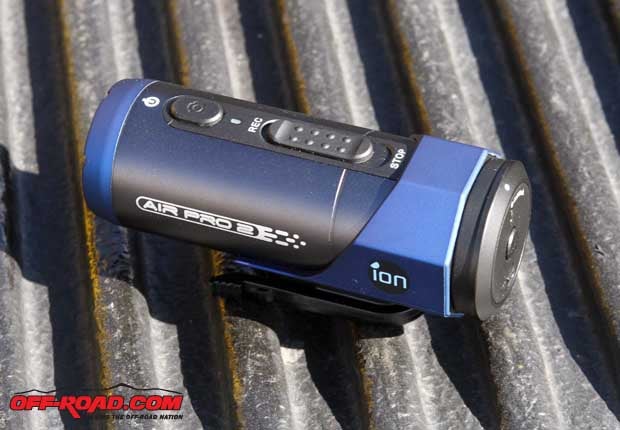
iON cameras have come onto the scene in a big way in the past few years. The company has been making a push into the action sports world of late, looking to improve upon the camera design of other companies already in the marketplace such as GoPro. We recently had the chance to test the Air Pro 2, and we came away impressed with its performance and design.
Check out iON Air Pro 2 Footage from Milestone MX Park, CA
Get the Flash Player to see this player. |
The iON Air Pro 2 tips the scales at a less than 5 ounces. Being lightweight is an important aspect for a device that could be mounted to a helmet, surfboard, mountain bike or other weight-sensitive areas. The Air Pro 2 is unique in that it has a longer, more cylindrical design compared to the square, boxy design of GoPros and other similar cameras. Unlike the GoPro, however, it comes in its own casing, which iON says is fully waterproof up to 30 feet. The camera simply turns on with the sliding of its power switch on top, which is followed by a vibration to alert the user it is recording.
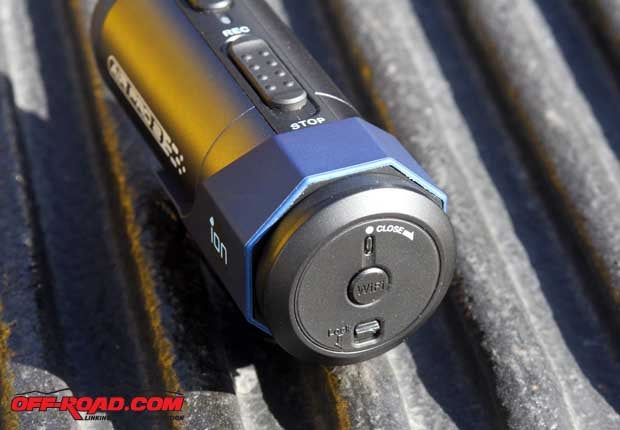
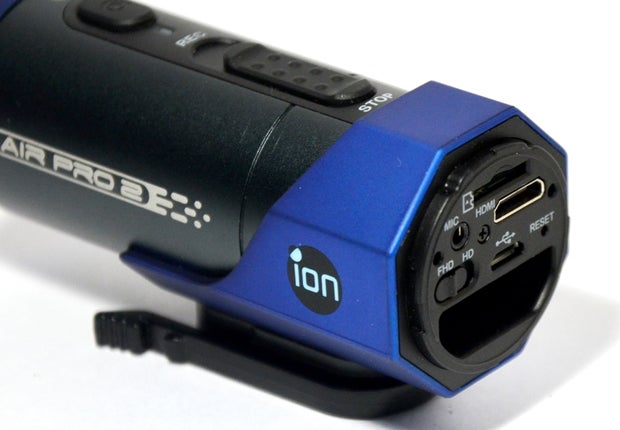
The iON’s wide-angle lens records at resolutions of 1080p, 960p, 720p as well as WQVGA with its 14-megapixel sensor (a big improvement over the 5-megapixel sensor in the first generation). The Air Pro 2 also features a unique Dual File recording that captures both an HD and lower-resolution WVVGA file simultaneously for easier sharing and loading on social media sites.
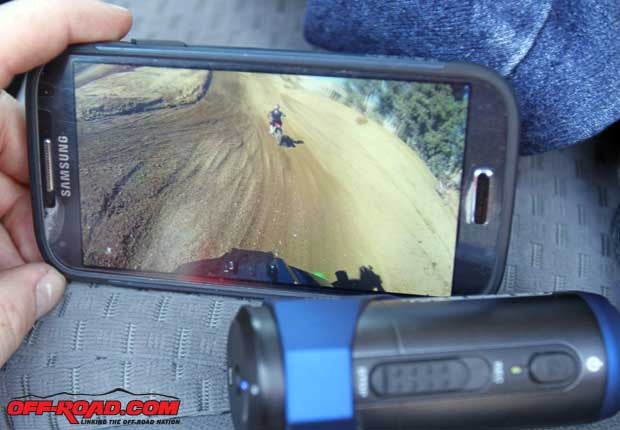
The Air Pro 2 is designed to work with a number of different add-on pieces called PODZ. For instance, our camera is equipped with the Wi-Fi PODZ, which allows the user to connect the camera to a phone or computer to view and share video. There’s also the Battery PODZ for up to 4 hours of recording battery life (the standard battery offers 2.5 hours of recording time), a Remote Podz for when using a phone or computer to view footage is not is not practical (such as shooting in the water), the Car PODZ for charging in the car, and the Microphone PODZ for improved quality audio. iON also provides 8 gigabytes of free cloud storage on its Cloud system.
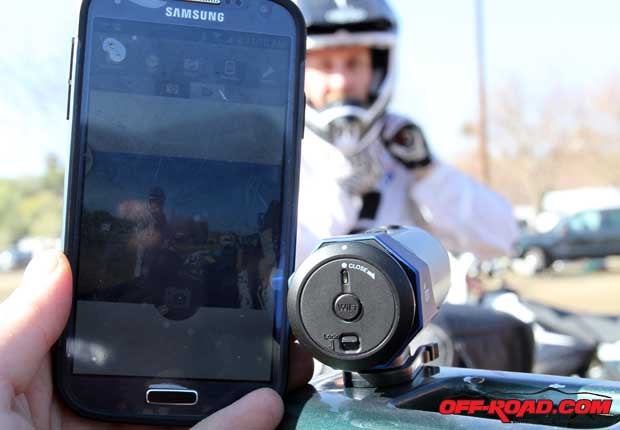
The controls for the Air Pro 2 are fairly straightforward. On the body of the camera are two buttons – a slider switch to start and stop recording, and a button just in front of that can power or turn off the device if held, or it can be pushed once to capture individual still shots. The memory card port, charging port, HDMI port, microphone port and FHD/HD switch are located on the back of the device and can be accessed once the pod is removed (in our case, once our Wi-Fi pod is removed).
Included in our Air Pro 2 Wi-Fi kit is the camera itself, a Wi-Fi PODZ, a carrying-case pouch, a USB cable and a wall plug to be used with the USB cable for charging, a composite cable for connecting to a TV, a secure string to help secure the camera to a mount or your person, a small flexible tripod, and a helmet mount with its unique ball-joint system.
Using the iON Air Pro 2
When it came time to put the Air Pro 2 to the test, we pulled everything out of the box and charged it up. The directions easily outline camera functions, and we were ready to do some recording and check out the footage.
We had an issue the first few times trying to use the camera, which was no fault of the Air Pro 2 but it did teach us something about it. On two different occasions we tried using the camera, charging the unit fully and inserting a 32 gb microSD card into the Air Pro 2. When we slid the Stop/Record switch to record, the camera buzzed as if it were recording but the small LED light on top remained green instead of turning to red. Thinking we were recording, we were a little disappointed to get home and realize we had no footage. We eventually figured out our memory card was corrupt (first time for us, though it does eventually happen to most cards), but it was good to know that the camera did note there was an error, hence the light not turning from green to red.
Having not downloaded the Wi-Fi software to oair our Android phone the first time, we realized quickly that the phone would allow us to check the camera (and even control it) ahead of time to make sure everything’s working. The iON software is free in the Google Play store (the same holds true on iPhones and iPads), and after following the directions and a few minutes of trial and error, we were able to connect and then view the camera’s perspective before and while recording. It also allows you to review footage you’ve shot from the phone or device.
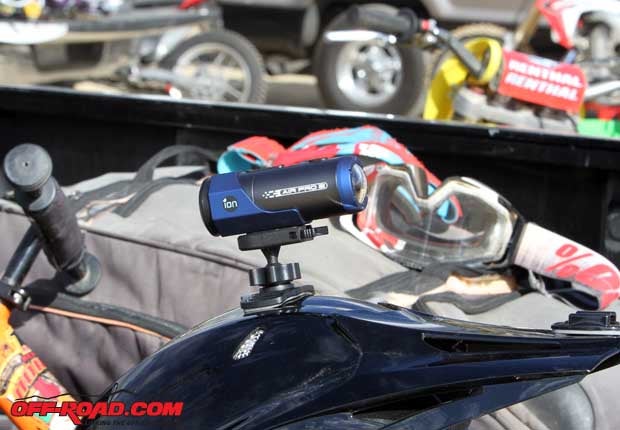
The camera is very simple to use in terms of turning it on and off. The Stop/Record rocker slides forward to record, and the vibration lets us know it is in fact recording – so there’s no asking your buddy to check and make sure the red light is on. When it is recording, the light will turn green to red after a few seconds, so the first time you start it up make sure to check this out to make sure your card is registering with the camera.
We tested the unit at Milestone MX park in Southern California on a unseasonably warm day in December. The Air Pro 2 was mounted to a helmet using the included double-sided 3M adhesive. The ball-mount system is a great design in that it is easy to adjust, and it locks into place and we had no trouble with it moving out of place during our ride – something that can happen with other cameras on the market from time to time. The ball mount does make the camera sit a little taller than others when mounted on top of the helmet – something to consider if you’re riding through thick brush or trees.

The footage is clear and the colors are true on the Air Pro 2. If there was a main difference to point out between the Air Pro 2 and GoPro’s Hero cameras, it would have to be the angle of the lens. The GoPro lens seems to offer more of a fish-eye wide-angle view, whereas the Air Pro 2 still offers a wide-angle view that is just a little more cropped.
After pairing our phone, we were able to check out our footage from our phone at the track as well, which was cool because not only did it let us know the camera was working it also showed the angle of the camera was where we wanted it. The footage looked crisp and colorful on the phone's screen, and we were able to fully appreciate the HD quality once back to a computer. The fact that both a low-res and high-res version record at the same time is a nice feature as well. We also proved the camera is durable, as we accidentally knocked it off the bed of the truck and the sturdy metal body took the hit with so signs of ill effect.
In the end, we feel the iON Air Pro 2 is a great camera that provides clear footage. It features a few thoughtful new tweaks in its design that improve upon other products in the market, and it's pricing is in line with other similar units. While our review focuses on the Air Pro 2, iON did just release the Air Pro 3. The Air Pro 3 has some added new features, including the ability to record video up to 60 frames per second at 1080p, as well as a new 12-megapixel sensor that offers up to 4000x3000-pixel still-image resolution that has improved low-light capability. The Air Pro 3 also features a new fog-free lens, a newly designed camera casing and improved underwater capability since it can now go to depths of 49 feet. The Air Pro 2 Wi-Fi kit retails for $249.99, while the iON Air Pro 3 Wi-Fi has a suggested retail price of $349.99. For more information about any of the iON Air Pro cameras and accessories, visit http://www.ioncamera.com/.
CONTACT
iON Worldwide
855-411-4466
http://www.ioncamera.com/


 Your Privacy Choices
Your Privacy Choices